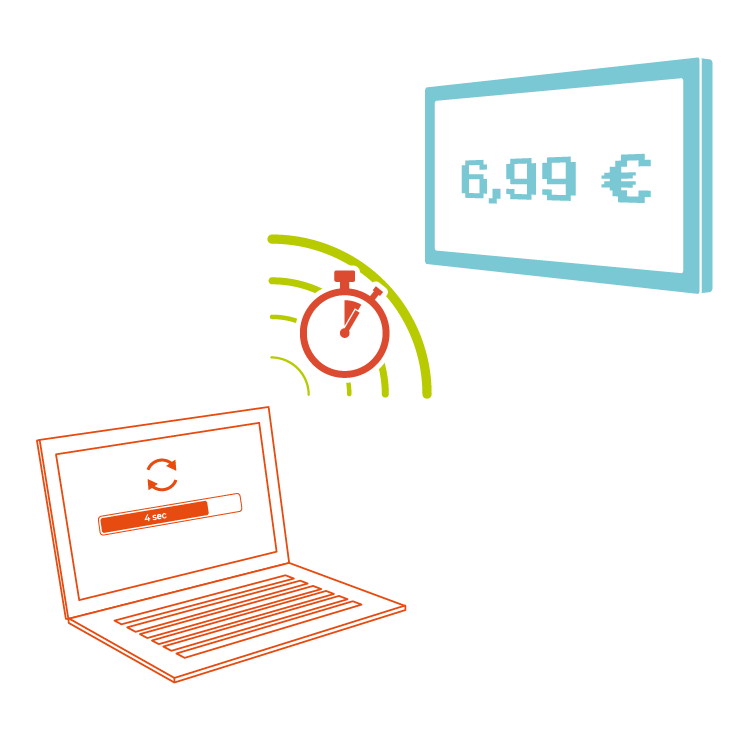A tempting price draws the customer’s attention, it helps the customer compare between different options and is often also the thing that ultimately decides the purchase decision. What the customer sees the price of the product from is of course the price tag. The traditional way of presenting the price is a paper price tag, but the new electronic shelf labels bring a whole range of features that save considerable time and, with it, also money. Below you will find three concrete examples.
3 reasons why electronic shelf labels save time and money
The traditional way of presenting the price is a paper price tag, but the new electronic shelf labels bring a whole range of features that save considerable time and also money. Below you will find three concrete examples.
3 reasons why electronic shelf labels save time and money
The traditional way of presenting the price is a paper price tag, but the new electronic shelf labels bring a whole range of features that save considerable time and also money. Below you will find three concrete examples.
1 The electronic shelf label is updated in seconds
When the prices in the store change, the price tags must also be updated. With traditional paper price tags, changing the price of one individual product is not a big deal, but if it is a promotional campaign, it may take a lot of time to change the tags. In the case of a store chain, you can multiply the time spent with the number of stores. When the same operation is carried out in connection with each campaign, the time spent on changing price tags on an annual basis is already financially significant.
The electronic shelf label can be updated in seconds. And not just one, but all labels in all the stores of the entire chain – at the same time. Even large campaigns can be launched in an instant. The staff does not have to manually go through the entire store, remove old price tags and attach new ones. Price information can be changed centrally from one place. The time saved can be used, for example, for personal customer service, which will certainly produce a better result than changing tags.


2 Electronic shelf labels do not show wrong prices
When updating price tags manually, human errors happen. Old price tags from the previous offer campaign are not changed, there are mistakes in the prices, or the tags end up with the wrong products. Any mistake in either direction creates problems. If the wrong price on the price tag is high, the product will remain on the shelf. A price tag that shows a price that is too cheap, on the other hand, makes the customer feel bad at the checkout, and the product may often have to be sold at the indicated wrong price.
With the help of electronic shelf labels, updates are made automatically and accurately, which reduces the risk of errors and thus also the time spent on correcting errors by the staff. Customers can always see the correct prices and valid offers, which reduces the number of complaints and makes the shopping experience smoother. Even at the cash registers, there are no longer unpleasant disputes that would cause dents in the company’s image.
3 The requirements of the Omnibus Directive are met
The purpose of the Omnibus Directive is to increase the transparency of pricing towards consumers. In terms of trade, the most important requirement of the directive is that when announcing a discount, only the lowest price at which the company has marketed the product in the 30 days preceding the campaign can be used as a reference price. Violation of the directive is of course sanctioned, and the most severe punishment can be a fine, the size of which is based on the company’s turnover.
By using electronic shelf labels, there is no fear of sanctions, because in electronc shelf labels, the prices can, if desired, be presented in accordance with the Omnibus Directive, meaning that the lowest selling price is automatically displayed on the price tag. Electronic shelf labels not only save time and effort in updating prices, but also ensure that the shop’s pricing is in line with current legislation. Again one less thing to worry about.

The advantages of electronic shelf labels in a nutshell
- facilitate the staff’s work and save working time,
- reduce problems caused by incorrect price information and
- take care of presenting the prices in the required manner, thanks to which the company avoids expensive sanctions.
Each point means either directly or indirectly a monetary saving. In addition to these, electronic shelf labels have features that help increase direct sales, such as
- the possibility of dynamic pricing, where prices can be changed according to, for example, the changing competitive situation
- rapid implementation of campaigns in all stores of the chain
- displaying real-time information related to the product, such as the product’s store availability on the label
If this article piqued your interest in knowing more, check out our product page for electronic shelf labels!

